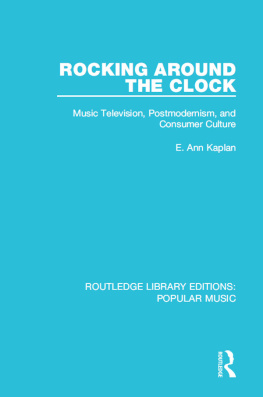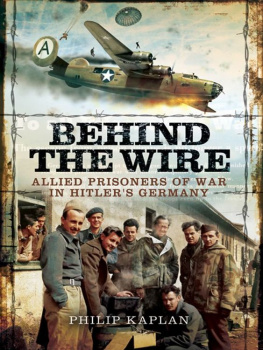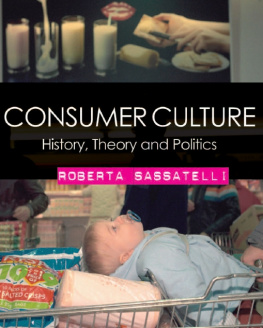Kaplan - Rocking Around the Clock: Music Television, Postmodernism, and Consumer Culture
Here you can read online Kaplan - Rocking Around the Clock: Music Television, Postmodernism, and Consumer Culture full text of the book (entire story) in english for free. Download pdf and epub, get meaning, cover and reviews about this ebook. publisher: Taylor & Francis Ltd, genre: Romance novel. Description of the work, (preface) as well as reviews are available. Best literature library LitArk.com created for fans of good reading and offers a wide selection of genres:
Romance novel
Science fiction
Adventure
Detective
Science
History
Home and family
Prose
Art
Politics
Computer
Non-fiction
Religion
Business
Children
Humor
Choose a favorite category and find really read worthwhile books. Enjoy immersion in the world of imagination, feel the emotions of the characters or learn something new for yourself, make an fascinating discovery.
- Book:Rocking Around the Clock: Music Television, Postmodernism, and Consumer Culture
- Author:
- Publisher:Taylor & Francis Ltd
- Genre:
- Rating:5 / 5
- Favourites:Add to favourites
- Your mark:
- 100
- 1
- 2
- 3
- 4
- 5
Rocking Around the Clock: Music Television, Postmodernism, and Consumer Culture: summary, description and annotation
We offer to read an annotation, description, summary or preface (depends on what the author of the book "Rocking Around the Clock: Music Television, Postmodernism, and Consumer Culture" wrote himself). If you haven't found the necessary information about the book — write in the comments, we will try to find it.
Kaplan: author's other books
Who wrote Rocking Around the Clock: Music Television, Postmodernism, and Consumer Culture? Find out the surname, the name of the author of the book and a list of all author's works by series.
Rocking Around the Clock: Music Television, Postmodernism, and Consumer Culture — read online for free the complete book (whole text) full work
Below is the text of the book, divided by pages. System saving the place of the last page read, allows you to conveniently read the book "Rocking Around the Clock: Music Television, Postmodernism, and Consumer Culture" online for free, without having to search again every time where you left off. Put a bookmark, and you can go to the page where you finished reading at any time.
Font size:
Interval:
Bookmark:

ROUTLEDGE LIBRARY EDITIONS: POPULAR MUSIC
Volume 9
ROCKING AROUND THE CLOCK
ROCKING AROUND THE CLOCK
Music Television, Postmodernism, and Consumer Culture
E. ANN KAPLAN

First published in 1987 by Methuen & Co. Ltd
This edition first published in 2016
by Routledge
2 Park Square, Milton Park, Abingdon, Oxon OX14 4RN
and by Routledge
711 Third Avenue, New York, NY 10017
Routledge is an imprint of the Taylor & Francis Group, an informa business
1987 E. Ann Kaplan
All rights reserved. No part of this book may be reprinted or reproduced or utilised in any form or by any electronic, mechanical, or other means, now known or hereafter invented, including photocopying and recording, or in any information storage or retrieval system, without permission in writing from the publishers.
Trademark notice: Product or corporate names may be trademarks or registered trademarks, and are used only for identification and explanation without intent to infringe.
British Library Cataloguing in Publication Data
A catalogue record for this book is available from the British Library
ISBN: 978-1-138-19432-8 (Set)
ISBN: 978-1-315-62255-2 (Set) (ebk)
ISBN: 978-1-138-64974-3 (Volume 9) (hbk)
ISBN: 978-1-315-62399-3 (Volume 9) (ebk)
Publishers Note
The publisher has gone to great lengths to ensure the quality of this reprint but points out that some imperfections in the original copies may be apparent.
Disclaimer
The publisher has made every effort to trace copyright holders and would welcome correspondence from those they have been unable to trace.
E. ANN KAPLAN
Rocking Around the Clock
MUSIC TELEVISION, POSTMODERNISM, AND CONSUMER CULTURE

First published in 1987 by
Methuen, Inc.
29 West 35th Street, New York NY 10001
Published in Great Britain by
Methuen & Co. Ltd
11 New Fetter Lane, London EC4P 4EE
1987 E. Ann Kaplan
Typeset in Great Britain
by Boldface Typesetters, 17a Clerkenwell Road, London EC1
Printed in Great Britain
by Richard Clay Ltd, Bungay, Suffolk
All rights reserved. No part of this book may be reprinted or reproduced or utilized in any form or by any electronic, mechanical or other means, now known or hereafter invented, including photocopying and recording, or in any information storage or retrieval system, without permission in writing from the publishers.
Library of Congress Cataloging in Publication Data
Kaplan, E. Ann.
Rocking around the clock.
Bibliography: p.
Includes index.
1. Rock videos United States. 2. MTV Networks.
I. Title.
PN1992.8.M87K36 1987 791.45750973 86-33113
ISBN 0 416 33370 2
0 416 33390 7 (pbk.)
British Library Cataloguing in Publication Data
Kaplan, E. Ann.
Rocking around the clock: music television,
postmodernism and consumer culture.
1. MTV
I. Title.
384.55560973 HE8700.72.U6
ISBN 0 416 33370 2
0 416 33390 7 (pbk.)
Contents
My very first thanks go to my daughter, Brett Kaplan, who first introduced me to MTV, although she has since moved on to other music. Interviews with Brett, Leo Margolf, and their friends, as well as with Paul Charney and his friends, helped me to understand how MTV was being received by some teenagers in 19845.
I next want to thank my good friend, Allon White, for the wonderful discussions during his visit to Rutgers University in 1983; many of my ideas for this book were generated in the course of our talks.
Martin Hoffman has been a constant source of encouragement and support in the writing of this book; he has borne many an hour of videos when he might have preferred other things, and helped me think ideas through when I came to an impasse.
I want to thank for their useful comments the Rutgers students who participated in seminars where MTV was briefly touched on. Gene Sobzchak was particularly helpful. Thanks also to the many students and faculty who came to all the talks on Music Television that I have given over the past few years; their thought-provoking comments, criticisms, and questions made me rethink some positions.
Peggy Phelan has been a thoughtful reader of various papers written as I was developing my ideas, and, in bringing MTV as a critical object to the attention of her graduate students at New York University, she has helped to develop interest in the area. She has also been invaluable in helping me locate specific videos and letting me borrow her tapes.
I want to thank music video director Eddie Barbarini for an illuminating interview, and both he and cameraman Bob Lechterman for allowing me to watch a video being made. Dr York, the producer of that video, also deserves thanks for being interviewed on the set.
I would like to thank the following book and journal editors for permission to reprint, in revised form, articles of mine that they published: first, Philip Drummond and Richard Paterson, editors of Television in Transition (London: British Film Institute, 1985) for A postmodern play of the signifier? Advertising, pastiche and schizophrenia in music television; the editors of Journal of Communication Inquiry, vol. 10, no. 1 (Winter 1986), for History, the historical spectator and gender address in music television; the editors of The Oxford Literary Review, vol. 8, nos 12 (Summer 1986), for Sexual difference, visual pleasure and the construction of the spectator in music television; and finally Deidre Pribram, editor of Cinematic Pleasure and the Female Spectator (London: Verso, 1987) for Whose imaginary? Text, body and narrative in select rock videos.
I would have liked to be in a position to thank MTV Publicity for talking to me about their side of things, but unfortunately my calls were never returned. I therefore had to rely on secondary sources in making my comments.
My thanks to the various publicity departments of record companies (under whose labels videos were produced) for their patient supplying of information I needed; I also want to thank the Music Department at Rolling Stone magazine for helping out with missing details for my Videography.
I want to thank the following rock stars and record companies for permission to print stills from the following videos: Madonna and Warner Bros Records for stills from Material Girl and Papa Dont Preach; Bruce Springsteen for stills from Born In The USA, Glory Days, and Im On Fire; Motley Crue and Elektra Records for stills from Smokin In The Boys Room and Home Sweet Home; Tina Turner and Capitol Records for stills from Whats Love Got To Do With It and Private Dancer; John Cougar Mellencamp and Riva/Polygram Records for stills from Authority Song and Hurts So Good; Pat Benatar and Chrysalis Records for stills from Love Is A Battlefield; Elektra Records and The Cars for stills from You Might Think; Peter Gabriel and Geffen Records for the still from Sledgehammer; Tom Petty and the Heartbreakers and MCA Records for the still from Dont Come Around Here No More; Artists Against Apartheid and Manhattan Records for the still from Sun-City.
I want to thank John Kline (New York Department of Photography) for his work photographing stills for You Might Think, Smokin in the Boys Room, Home Sweet Home, Sledgehammer, Born in the USA, Glory Days, Im On Fire, Hurts So Good, Authority Song, Whats Love Got To Do With It?, Dont Come Around Here No More. Other stills photographed by Patti Sapone (Blakely/Sapone Productions).
Next pageFont size:
Interval:
Bookmark:
Similar books «Rocking Around the Clock: Music Television, Postmodernism, and Consumer Culture»
Look at similar books to Rocking Around the Clock: Music Television, Postmodernism, and Consumer Culture. We have selected literature similar in name and meaning in the hope of providing readers with more options to find new, interesting, not yet read works.
Discussion, reviews of the book Rocking Around the Clock: Music Television, Postmodernism, and Consumer Culture and just readers' own opinions. Leave your comments, write what you think about the work, its meaning or the main characters. Specify what exactly you liked and what you didn't like, and why you think so.
















